When and how to transplant strawberries to a new place in spring, summer and autumn: timing and methods of reproduction
You fell for this stuff because you most likely need to either plant or transplant strawberries to a new location, right? Basically, they are the same thing, you need to create a new strawberry garden in one of the possible ways. To be honest, this activity is not too simple, but absolutely necessary.
Why, when and how to most correctly plant or transplant garden strawberries will be discussed in this article below.
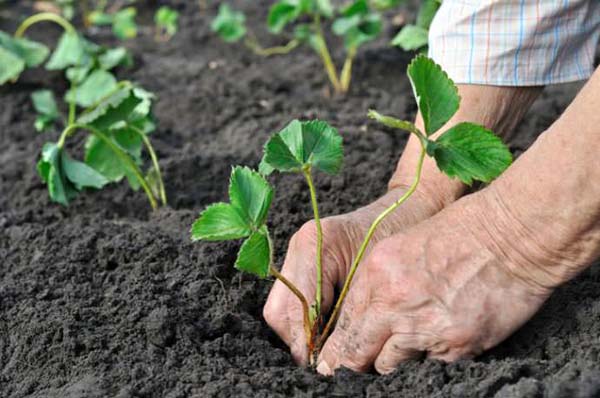
Content
- 1 Why and why it is imperative to transplant strawberries
- 2 When is it better to transplant strawberries to a new place - in spring, summer or autumn
- 3 Strawberry propagation (transplantation) methods
- 4 Rules for transplanting (planting) strawberry seedlings and answers to frequently asked questions
- 4.1 When is the simplest strawberry transplant (without reproduction and dividing the bush) to a new place
- 4.2 Preparing the beds (soil) for transplanting
- 4.3 Is it possible to transplant flowering garden strawberries
- 4.4 Is it possible to transplant (plant) strawberries in the old place
- 4.5 At what distance to plant
- 5 Strawberry care after transplanting
Why and why it is imperative to transplant strawberries
One of the features of the development of strawberries is a gradual increase in diameter of the bush due to the growth of new rosettes (it would be more correct to call them horns), which in the future negatively affects its fruiting.
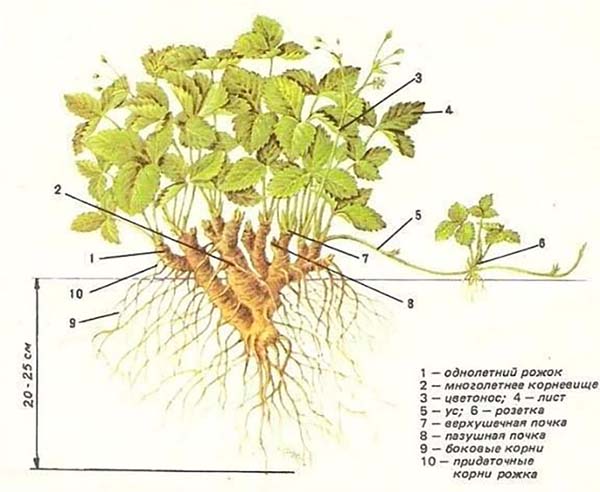
When strawberry bushes grow like that, they become cramped, food begins to lack, so the plant should be renewed (rejuvenated) to return its optimal productivity, i.e. transplant or transplant (for example, if you originally planted the bushes too close to each other).
Interesting! Strawberry bush development scheme:
- an annual strawberry seedling has 1 horn (this is the maternal root);
- for 2 years of life - already 2-3 horns (the most bountiful harvest);
- for 3 years of life - already 6-9 horns (the yield is noticeably reduced).
Thus, strawberries can grow well in one place (without transplanting), as a rule, no more than 3 years. Actually, you yourself will notice how the bush grows, and the berries themselves begin to shrink.
In other words, strawberries itself will tell you when to transplant, because there are certain varieties and hybrids that can bear fruit normally for more than 3 years, of course, with proper care and regular feeding.
What needs to be done to continue to get bountiful harvests of tasty and large strawberry berries? Here's what:
- for the 2nd year, it is mandatory to propagate strawberries - mustache or by dividing a bush;
- in the 3rd year, overgrown bushes should be either disposed of (thrown away and not tortured), or the old bush should be divided.
By the way! Some summer residents who have no problems with a planting site (in the sense that the site is large and not planted), do not get rid of old strawberry bushes, since the most delicious jam is made from small and fragrant berries.
When is it better to transplant strawberries to a new place - in spring, summer or autumn
It is impossible to unequivocally answer the question of when it is better to transplant strawberries - in spring or autumn (more precisely, in the summer-autumn period). But we can highlight the benefits of planting in each of the seasons:
- The advantage of transplanting in spring is the fact that during this period there is a lot of moisture in the ground and the air is not hot. During this time, young garden strawberries will have time to take root and develop a good root system.
- If transplanted in the fall, then before the onset of frost, strawberry bushes will also have time to take root very well and give young green leaves. In addition to this obvious advantage, it often rains in the fall, which means there will be no need for frequent watering. In addition, at this time it is corny more time than in the spring turmoil with seedlings.
Transplant in spring
The optimal timing for transplanting strawberries in spring directly depends on your climatic zone and current weather conditions. As a rule, in the South of Russia (as in Ukraine) it is March-April, in the Middle Lane (Moscow region) - the end of April - May, in the Urals and Siberia - the second half of May - early June.
The general rule for determining the right time for transplanting strawberries is considered the moment when the soil completely thaws and the air temperature rises to +10 degrees. Although, if the soil has already thawed, but the temperature is zero (and according to the weather forecast it will only rise), then the procedure can be carried out, the strawberries will be able to survive light frosts.
Important! The main advantage of transplanting strawberries by dividing the bush in the spring is the fact that you can get a crop (albeit small) in the year of division.
As for suitable methods of transplanting (propagating) strawberries, in the spring this can only be done by dividing the bush, or by planting seedlings grown from seeds. Of mustache propagate bushes will not work, since they begin to form only in summer.
Transplant in summer
You can transplant strawberries in the summer. But it is very undesirable to do this if there is a strong heat, for example, in July.But it is in August (2 weeks after fruiting) that the most favorable time comes for transplanting strawberry bushes to a new place.
Important! Strawberries should not be planted in the summer heat, because the roots cannot yet normally receive nutrition from the ground, and the hot air causes the leaves to evaporate moisture strongly. As a result, such bushes will either take root for a very long time and painfully, or dry out (without proper care).
If you nevertheless decide to plant strawberries in the middle of summer, then you need to take very careful care of it, namely, water it with sprinkling almost every day (but the drops should be small).
Transplant in autumn
Clarification! Rather, it is correct to talk about a summer-autumn transplant.
The best time to transplant strawberries is the beginning of autumn, that is, around September. One of the main advantages of transplanting in the fall is the fact that at this time strawberries can be propagated, in addition to dividing the bush, by planting seedlings grown from seeds, as well as with the help of a mustache that will grow over the summer. But you need to root the mustache in the summer, in June-July.
However! If you live in the northern regions, for example, in the Urals or Siberia, that is, your frosts come early, then you should not transplant strawberries in the fall (or at the end of summer), it is better to do this in the spring (or summer) so that the bushes have time to root normally ...
Video: transplanting strawberries in the fall
Strawberry propagation (transplantation) methods
There are only 3 methods for breeding strawberry bushes:
- division of the bush (horns);
- rooting mustache;
- growing seedlings from seeds.
Next, let's talk in detail about each.

Video: 3 ways to propagate garden strawberries (strawberries) - seeds, mustache and dividing the bush
Division of the bush (propagation by horns)
Step-by-step instructions for dividing a strawberry bush:
- Dig up an adult overgrown bush along with an earthy clod. This must be done carefully (without damaging the roots), carefully digging in with a shovel from all sides.
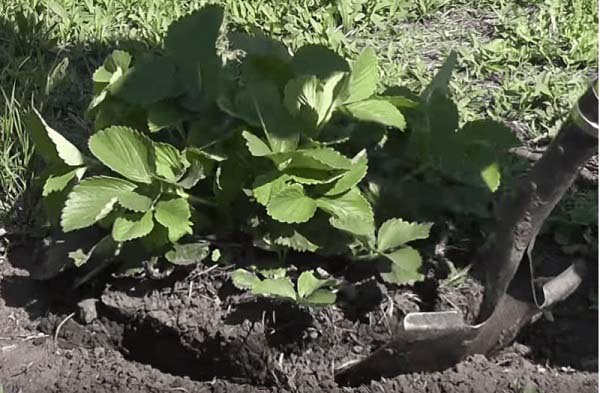
- Place the strawberry bush in a wide container.
- Now you need to get rid of all the old dry leaves and shoots. Then free the roots from the ground.
- Next, lower the bush into a basin and fill it with water so that the roots are completely in the water, so it will be easier to clean (rinse) them of the remaining soil.
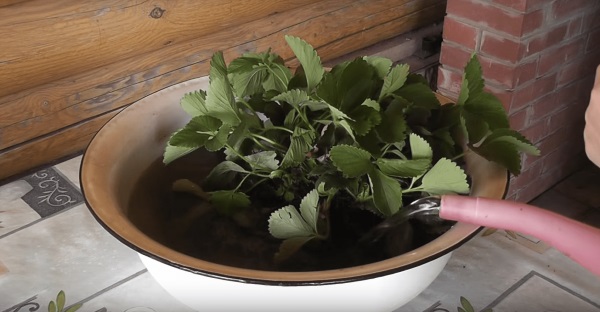
- In the process of soaking the earthen coma, the bush will, so to speak, share itself, you just need to help slightly with your hands, separating the horns from each other.
- All other horns (not independently separated) should be cut off from the mother plant with a knife, while it is important that each horn has an apical bud and roots (see the diagram of the old strawberry bush in the first paragraph of the article).
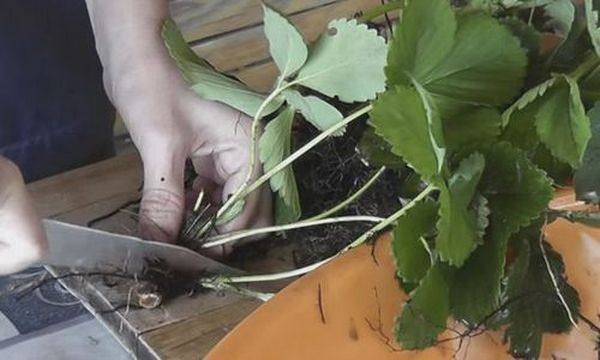
- Each delenka now needs remove excess leaves (leaving 2-3 central ones on 2 stalks, the greenest and freshest, and the remaining ones should be cut with scissors by about 1/2 - to reduce the evaporation of moisture by them), peduncles and prune old (dark) roots, leaving the youngest (light).
- Now, for better survival, the roots can be disinfected in a solution Fitosporin, and also process in one of the growth stimulants, such as "Kornevin", "Epin" or "Zircon". Or use the old method: dip it in a clay-dung mash, which is very easy to prepare. To do this, you need to take 3 parts of clay and 1 part of manure, and then dilute with water until you get "thick sour cream".
- Everything, the seedlings can be planted in open ground or, as an option, slightly grown by planting in separate pots.
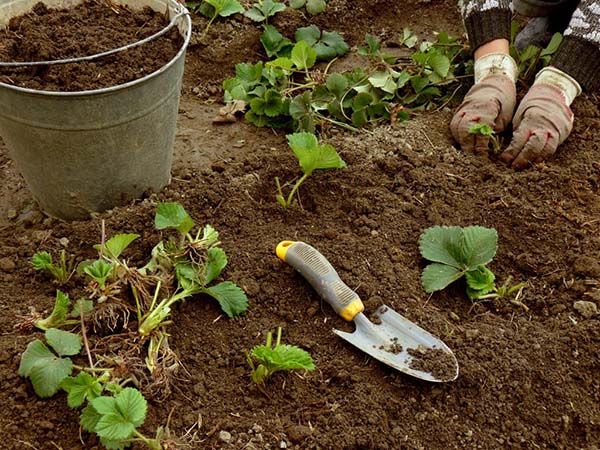
Step-by-step guidance for further planting of divided strawberry seedlings (horns):
- Choose a place and prepare (fertilize) the garden.
- Dig planting holes depending on the size of the root system.
- Spill wells with plenty of water.
- Carefully place the seedling in the hole and dig in.
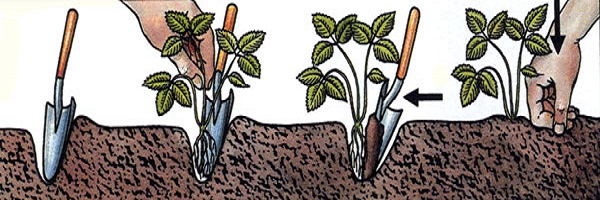
- The most important thing in this case (when planting a plant with an open root system) is not only to correctly position the growth point of the bush (heart) at ground level, but to stretch the roots well vertically (without bending).If you dig too deep, the plant will blow out. If you plant it high, then expose the base of the roots, from which the bush will dry out and simply freeze out in winter.
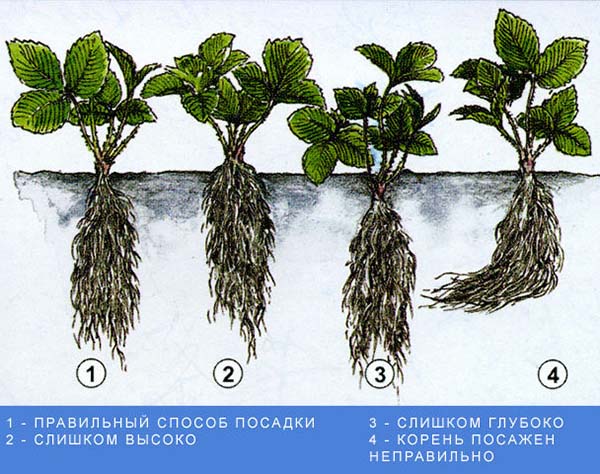
- Water abundantly.
- Mulch planting.
Worth knowing! The method of reproduction by dividing the bush is applicable to any type of strawberry, including remontant.
Video: reproduction of strawberries (garden strawberries) by dividing the bush (horns)
Note! When dividing an old bush, the delenki, most likely, will no longer give a strong and stable harvest, since these are already quite severely depleted bushes. Therefore, this method should be used only in exceptional cases, for example, if the bushes are frozen over the winter or it is a mustacheless variety.
Rooting the whiskers (or rosettes)
Advice! The site already has a separate detailed article about how to propagate strawberries with a mustache in summer.
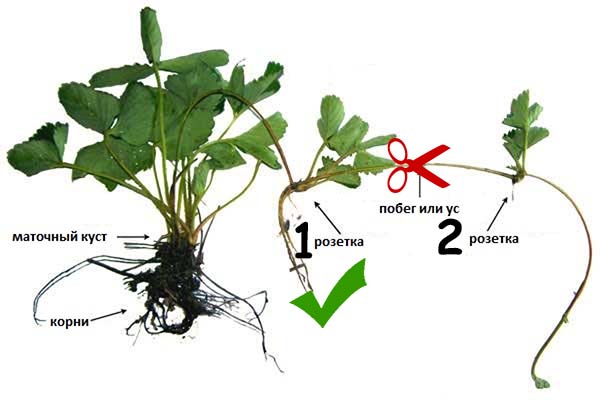
Important! This method of propagation of strawberries is completely non-traumatic, and the survival rate of bushes is almost 100%.
Growing from seeds
Important! Learn more about how to plant and grow strawberry seedlings from seeds at home you can by reading this separate material.
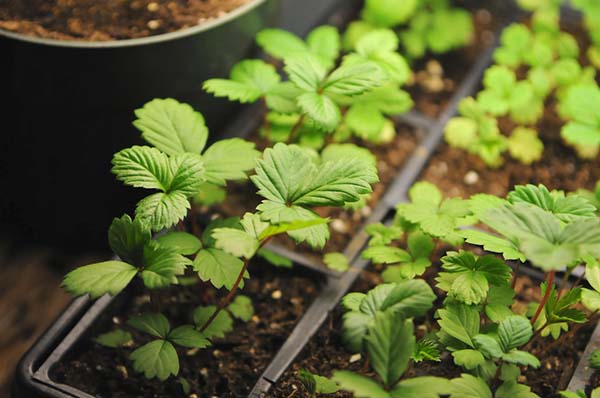
Rules for transplanting (planting) strawberry seedlings and answers to frequently asked questions
Below you can find out the answers to current questions about the correct transplantation (planting) of strawberry seedlings.
When is the simplest strawberry transplant (without reproduction and dividing the bush) to a new place
In the spring before flowering (before ejection of the peduncles) or in late summer-autumn (2 weeks after the end of fruiting).
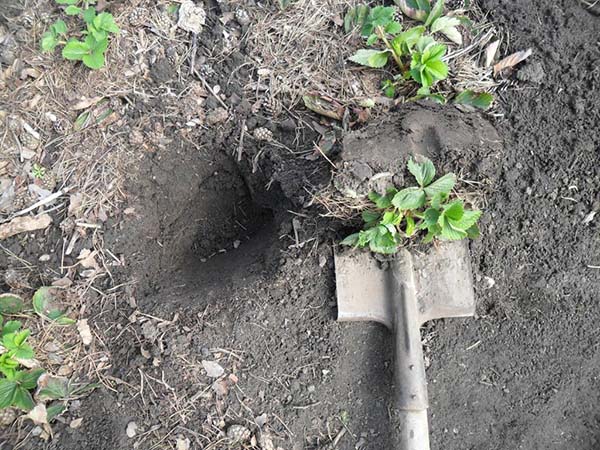
How to move a bush from one place to another:
- Remove old leaves (dark green) with spots, and you can also trim the leaves additionally (so that less moisture evaporates)
- Trim the mustache (if transplanting in summer-autumn)
- Prepare a large hole for planting the size of an earthen ball and shed liberally.
- Dig out a bush together with a lump of earth and take it to a new place right on a shovel, carefully lowering it into a wet hole.
- Drizzle lightly with water.
- Mulch at will and need.
Video: transplanting strawberries to a new place - expanding strawberry areas by planting thickened plantings
Preparation beds (soil) for transplanting
To prepare a new place (soil) for transplanting strawberry bushes, you will need:
- Try to completely rid the garden of weeds.
- Shed Fitosporin (for disinfection) and let it stand for a couple of days (or this can be done after disembarkation).
- Loosen immediately before planting.
- Scatter wood ashso that it covers the entire area with a thin layer (200 grams per 1 square meter), or a similar potassium fertilizer (for example, 20-30 grams of potassium sulfate).
- Then add superphosphate (30-40 grams per 1 square meter).
- Pour in excellent humus and compost (6-8 kg per 1 square meter).
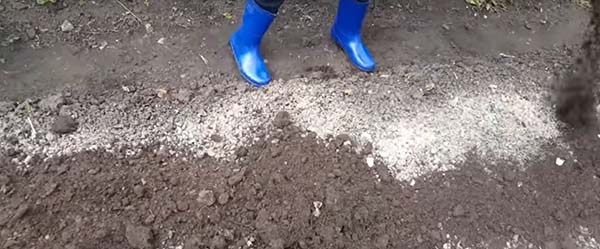
- Some gardeners recommend digging the garden bed onto the bayonet of a shovel to mix the fertilizer with the soil, others (as in the video below) advise planting directly on the fertilizer layer.
Is it possible to transplant flowering garden strawberries
Yes, it is possible, but it is recommended that all peduncles be removed without fail, so that the plant does not waste extra energy, but focuses on the survival of the roots in a new place. But still, it is better to carry out all breeding procedures either before flowering (before ejection of the peduncles), or after the end of fruiting (after 2 weeks).
However! You can also transplant flowering strawberries (but only young bushes), while it is imperative to preserve an earthen ball (transfer the bushes directly on a shovel). In this case, the strawberry bushes will not notice anything and will continue to bloom further. But if the roots become bare during the transfer, then soon, they themselves will shed the flowers and begin to hurt ...
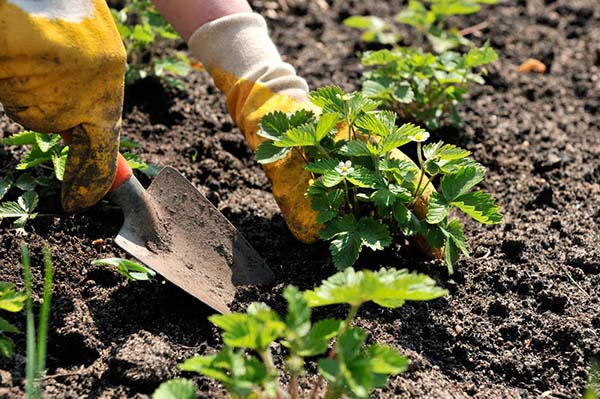
Is it possible to transplant (plant) strawberries in the old place
Yes, you can, especially if you treat (spill) the bed with a solution Fitosporin (for soil disinfection).
But still, it is better to change the place of the garden every 3-4 years and plant garden strawberries after onions and garlic, carrots, beets, radishes, legumes, siderates.
At what distance to plant
It is most convenient to plant strawberries according to the most standard scheme: 60-70 by 25-30 centimeters (tape in 1 line or rows). But there are different ways of planting - both simpler (solid carpet) and complex (tape in several lines).
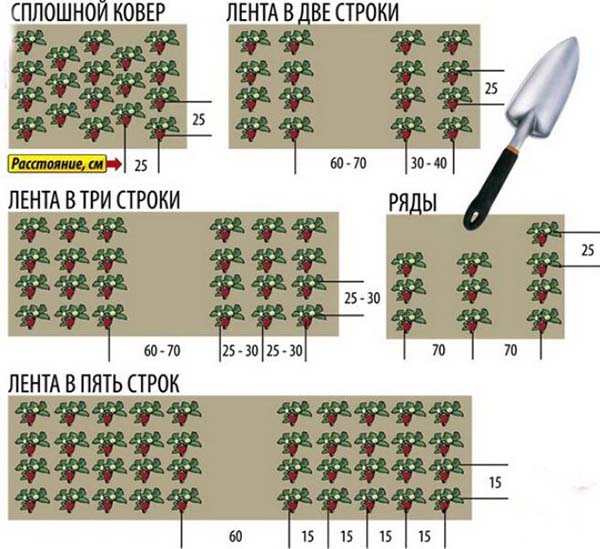
Strawberry care after transplanting
It is necessary to take care of the transplanted bushes of garden strawberries carefully, but in general the care is quite simple - in general, regular watering is necessary.
So, after the transplant for at least 1-2 weeks should be careful monitor humidity and water regularly strawberry bushes. However, you need to try not to overdo it and not flood, especially if you mulched strawberry patch... About so much strawberries are needed to somehow settle in a new place. Further, watering should be carried out as the earth dries up.
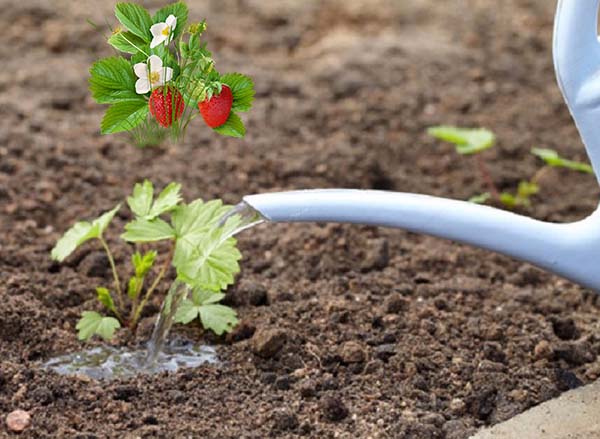
In the first year, it makes no sense to additionally feed strawberries, of course, if you fertilized the garden well during transplantation.
Note! Equally important is correct prepare strawberries for winter (especially transplanted and young ones), namely cover correctly and well... You can find detailed information in this material.
Correct transplanting is exactly what strawberries lack to restore the highest productivity and the prospects for a rich harvest. It is worth taking a closer look at interesting proposals for transplanting a strawberry bush and choosing the most optimal for you.
Interesting! And the author of the next video for a quick and convenient strawberry transplant suggests making and using a special planter.
Video: how to quickly transplant strawberries


Hello! I liked the article very much, I would like to read others by this author and generally get to know the site better. But you have something with the site - it is very difficult to move the page up and down, besides, it starts to "jump". Understand, please. The material you give is sensible, unlike other sites, and it is inconvenient to read it.
Good day! Are you viewing the site from a mobile version or from a laptop / desktop computer? If the latter, then you have disabled ads, i.e. is there a special program - Adblock?
My plot of 2x3 meters is very stony and I was given a dozen pieces of strawberry seedlings, I had to plant them. In the first year it bore fruit, and I broke off the antennae, then last year it grew very well. I didn't touch anything. All winter it lay like a green carpet, this year should it be excavated and transplanted to the same place?
Good day!
If the bushes have grown so much that they become cramped, then it really is worth thinning and planting them, propagating in one of the vegetative ways, but you can leave them for 3 years.
As for the place, it is very desirable to treat (spill) the bed with a solution of Fitosporin (for disinfecting the soil) and apply the appropriate fertilizers (at least humus and wood ash), you can directly into the holes,in which you will plant seedlings.
Nadezhda, hello! For some reason, by July, my strawberry leaves become lemon-colored, although in the spring they were green, beautiful
Good day! If lemon with bright green streaks, then this is most likely non-infectious chlorosis caused by lack of iron, which, most often, is observed against the background of excess lime, i.e. in case you have alkaline soil (pH 7 and above). The easiest way is to do foliar feeding (spraying on the leaves) with iron chelate or Ferovit, but this will have to be done every season until you bring the acidity of the soil to a neutral reaction.
Good day!
The strawberry bushes are powerful, tall, the leaf is green, and in general there are not many berries ... I watch pictures, videos - the bushes are not large, with berries. And I am struggling in my bed with difficulty, although I planted in the spring at a great distance from each other. The previous strawberries on this bed were almost zero, turned into dust, and ate mice. Therefore, the landing was fresh. Please advise the grade. I live in Novosibirsk.
Good day!
Most likely, it's not the variety, but the fertilizers used. For abundant fruiting, you need a lot of potassium and phosphorus. But the excessive use of nitrogen fertilizers (urea, manure, herbal infusions) leads to a violent growth of green mass, as a result, the bushes are powerful and green, but there are no berries.